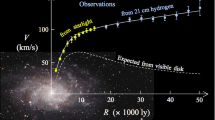Main Conclusions
-
1)
The probability distributions of the basic kinematic parameters of radio galaxies can be described by simple analytic expressions (the gamma distribution (7) with γ=2 and 3 and the distribution (9)), these making it possible to determine from observations the characteristics separation velocity of the components under the assumption of a fixed lifetime of the radio sources.
-
2)
Application of the proposed method to analysis of the sample of radio galaxies in [2] showed that the velocity of the hot spots in the “heads” of powerful radio galaxies has characteristic magnitude v≲9000 km/sec, the asymmetry parameters R and Q being due to differences in the initial conditions of the ejections and differences in the parameters of the surrounding intergalactic medium.
-
3)
An important parameter of a sample of radio sources is the maximal observed linear size1 *max , since the characteristic velocity v of the motion of the components and the characteristic lifetime T of the sources depend on it.
Similar content being viewed by others
Literature Cited
M. Ryle and M. S. Longair, Mon. Not. R. Astron. Soc.,136, 123 (1967).
M. S. Longair and J. M. Riley, Mon. Not. R. Astron. Soc.,188, 625 (1979).
D. G. Banhatti, Astron. Astrophys.,84, 112 (1980).
J. Katgert-Merkelijn, C. Lari, and L. Padrielli, Astron. Astrophys. Suppl. Ser.,40, 91 (1980).
G. Swarup and D. G. Banhatti, Mon. Not. R. Astron. Soc.,194, 1025 (1981).
C. D. Mackay, Mon. Not. R. Astron. Soc.,162, 1 (1973).
B. L. Fanaroff and J. M. Riley, Mon. Not. R. Astron. Soc.,167, 31P (1974).
C. J. Jenkins, G. G. Pooley, and J. M. Riley, Mem. R. Astron. Soc.,84, 61 (1977).
D. Saikia, Mon. Not. R. Astron. Soc.,197, 11P (1981).
Yu. N. Pariiskii and N. S. Soboleva, Pis'ma Astron. Zh.,6, 67 (1980).
S. M. Simkin, Astrophys. J.,222, L55 (1978).
L. Rudnick, W. C. Saslaw, P. Crane, and J. A. Tyson, Astrophys. J.,246, 647 (1981).
G. K. Miley, T. M. Heckman, H. R. Buther, and W. J. Breugel, Astrophys. J.,247, L5 (1981).
R. D. Blandford and M. J. Rees, Mon. Not. R. Astron. Soc.,169, 395 (1974).
Additional information
Leningrad State University. Translated from Astrofizika, Vol. 19, No. 3, pp. 461–469, July–September, 1983, 1983.
Rights and permissions
About this article
Cite this article
Baryshev, Y.V. Kinematic models of powerful radio galaxies and statistics of extended components. Astrophysics 19, 257–263 (1983). https://doi.org/10.1007/BF01007339
Revised:
Accepted:
Issue Date:
DOI: https://doi.org/10.1007/BF01007339




